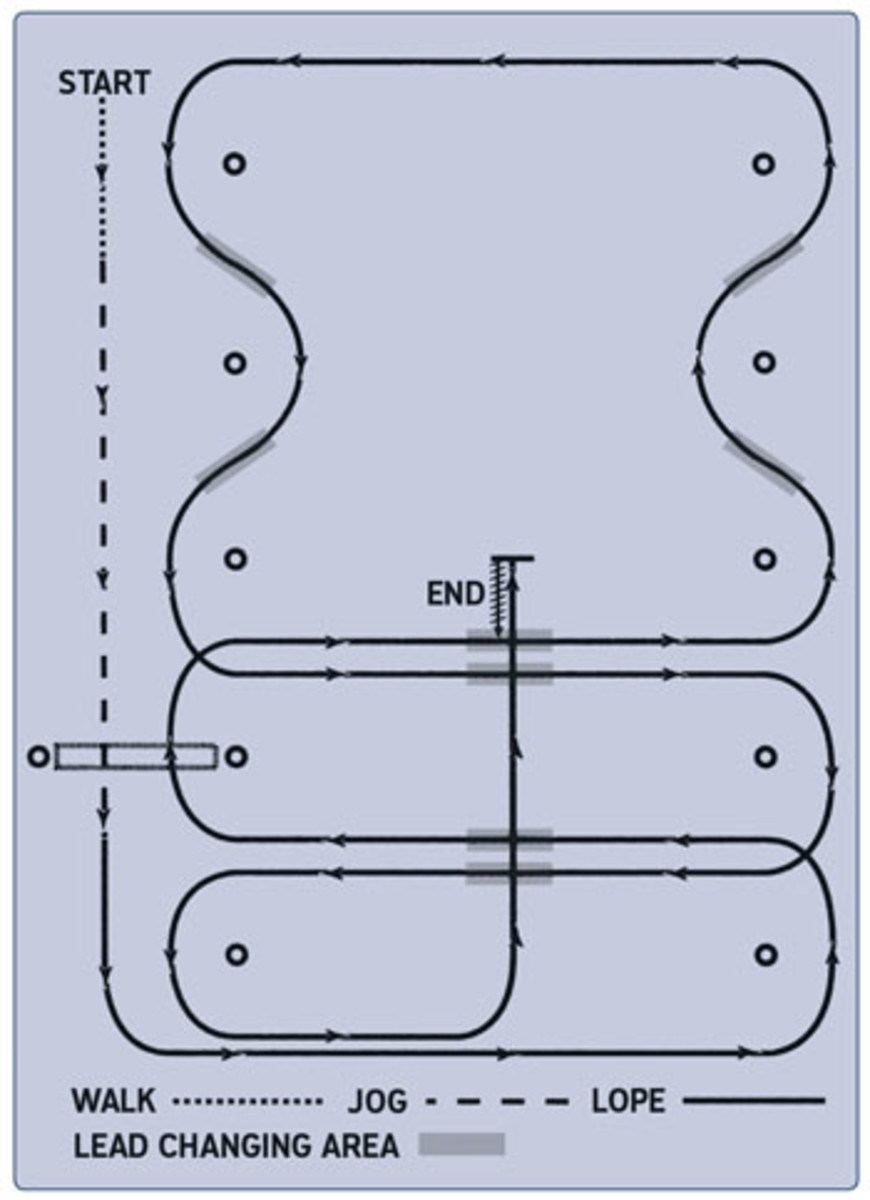By mixing crossing and line changes, Pattern 3 keeps veteran horses fresh, and by not requiring four line changes in a row, it’s a good pattern for green horses, too.

A new development in this pattern includes a cone set at the start, so it’s clear where I begin to judge you. Prepare your performance at the cone, by establishing your horse’s ideal frame there.
Make sure you step off at a walk—allowing your horse to jog off from the cone incurs a penalty. Attain a flat-footed, relaxed walk on a soft rein to demonstrate your horse’s manners and set the tone for your overall performance.
Halfway between the first two cones, pick up a solid, two-beat jog, and maintain an established frame toward the log. You’re the only team on course, so set your horse’s best pace without worrying about comparison, but avoid a crawling pleasure jog—it takes too long, and won’t help him clear the log. A solid pace’s cadence should enable him to cross the log without a kick or tick, and the resulting penalties. If needed, subtly adjust his stride. If he adjusts his stride on his own, that’s OK with me, too—it shows he knows his job.
Jog four or five strides after the log to demonstrate your control of the lope transition. If he lopes too soon, it’s penalized as a break of gait. He should step into the lope without changing his frame, or causing you to pick up your reins too much. Your cues can be visible, but they must be subtle. As you step into the lope, immediately establish a cadenced pace to maintain throughout the entire pattern. I’ll be watching your lope around the bottom of the pattern for manners, pace, and frame.
Turn left and travel straight across the arena for the first crossing change. For every lead change, maintain your established pace. A horse must move forward, with his legs reaching forward, rather than up and down, for a good lead change. The quality and location of changes (in the designated zones halfway between cones) are critical to your score. Make sure you locate the pattern’s center, (which isn’t necessarily the arena’s center point) for your changes.
Ideally, your horse won’t change his frame or rhythm loping over the log. Ride the arc over the log, shallow or deep, depending on your horse’s stride, so it appears smooth. Driving and adjusting to it isn’t pretty. Common errors are breaking gait to the trot and changing leads over the log. Splitting the log (each foot of a front or hind pair landing on opposite sides of the log) is penalized; so, if your horse adjusts himself to avoid this, I’ll credit him. Re-establish your pace for your next lead change if he lost it over the log.
Departing your second crossing change, stay in the middle of the line, or slightly right, so you don’t hug the cone on your left. You’ll need the room to set up pretty and correct line changes. Take a straight course down the line, rather than a loopy serpentine, achieving just enough lateral movement to clear the cones. Your horse’s body must be straight for good lead changes. As you pass the marker on the left to begin the line, his body should already be straight, not arced.
Find the designated middle zones between cones for the line changes, three to four strides past each, depending on your horse’s stride length. Don’t over- or under-steer, and keep your pace steady.
Loping around the top of the pattern, check your pace and frame, and focus ahead. Keep your body still so your horse doesn’t change leads by accident. Maintain the left lead with your outside leg, if needed.
After your third and fourth line changes, look left, don’t get too deep to the log before turning left, and find the center of the cones. When rounding the cones at the pattern’s edge, don’t go all the way to the wall, but don’t make little doughnuts around them. Give these turns reasonable, uniform space to make the pattern look proportional.
For the final lead change, don’t relax too much, or your horse might break gait. Find the pattern’s center, be sure to pass the log, and stop even with the plane of the third cone. Be leery of an unintended lead change. Perform a balanced, soft halt and a straight, obedient back up, and you’re finished.
Leslie Lange and husband Tom operate T&L Quarter Horses in Greeley, Colorado. Leslie was the AQHA’s Professional Horseman of the Year in 2003, and in 2007, she earned fifth place at the AQHA World Show in junior Western riding, and third at the NSBA World Show in senior Western riding.






